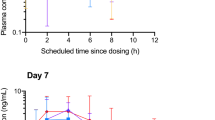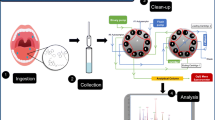Abstract
Oral fluid (OF) is a valuable biological alternative for clinical and forensic drug testing. Evaluating OF to plasma (OF/P) cannabinoid ratios provides important pharmacokinetic data on the disposition of drug and factors influencing partition between matrices. Eleven chronic cannabis smokers resided on a closed research unit for 51 days. There were four 5-day sessions of 0, 30, 60, and 120 mg oral ∆9-tetrahydrocannabinol (THC)/day followed by a five-puff smoked cannabis challenge on Day 5. Each session was separated by 9 days ad libitum cannabis smoking. OF and plasma specimens were analyzed for THC and metabolites. During ad libitum smoking, OF/P THC ratios were high (median, 6.1; range, 0.2–348.5) within 1 h after last smoking, decreasing to 0.1–20.7 (median, 2.1) by 13.0–17.1 h. OF/P THC ratios also decreased during 5-days oral THC dosing, and after the smoked cannabis challenge, median OF/P THC ratios decreased from 1.4 to 5.5 (0.04–245.6) at 0.25 h to 0.12 to 0.17 (0.04–5.1) at 10.5 h post-smoking. In other studies, longer exposure to more potent cannabis smoke and oromucosal cannabis spray was associated with increased OF/P THC peak ratios. Median OF/P 11-nor-9-carboxy-THC (THCCOOH) ratios were 0.3–2.5 (range, 0.1–14.7) ng/μg, much more consistent in various dosing conditions over time. OF/P THC, but not THCCOOH, ratios were significantly influenced by oral cavity contamination after smoking or oromucosal spray of cannabinoid products, followed by time-dependent decreases. Establishing relationships between OF and plasma cannabinoid concentrations is essential for making inferences of impairment or other clinical outcomes from OF concentrations.





Similar content being viewed by others
Abbreviations
- 11-OH-THC:
-
11-hydroxy-THC
- CBD:
-
Cannabidiol
- CBN:
-
Cannabinol
- DUID:
-
Driving under the influence of drugs
- LOQ:
-
Limit of quantification
- OF:
-
Oral fluid
- OF/P:
-
Oral fluid to plasma
- THC:
-
∆9-tetrahydrocannabinol
- THCCOOH:
-
11-nor-9-carboxy-THC
- Tid:
-
Ter in die (three times a day)
References
United Nations Office on Drugs and Crime (2012) World Drug Report 2012. United Nations Publication, Sales No. E.12.XI.1. Vienna, Austria
Substance Abuse and Mental Health Services Administration (2012) Results from the 2011 National Survey on Drug Use and Health: Summary of National Findings. NSDUH Series H-44, HHS Publication No. (SMA) 12-4713. Rockville, MD
European Monitoring Centre for Drugs and Drug Addiction (2012) Annual Report 2012: The State of the Drugs Problem in Europe. Publications Office of the European Union. Luxembourg
Australian Institute of Health and Welfare (2011) 2010 National Drug Strategy Household Survey report. Drug statistics series no. 25. Cat. No. PHE 145. Canberra
Huestis MA (2002) Cannabis (marijuana)—effects on human behavior and performance. the effects of drugs on human performance and behavior. Central Police University Press, Taipei
Wadsworth EJ, Moss SC, Simpson SA, Smith AP (2006) Cannabis use, cognitive performance and mood in a sample of workers. J Psychopharmacol 20:14–23
Macdonald S, Hall W, Roman P, Stockwell T, Coghlan M, Nesvaag S (2010) Testing for cannabis in the work-place: a review of the evidence. Addiction 105:408–416
Li G, Baker SP, Zhao Q, Brady JE, Lang BH, Rebok GW, DiMaggio C (2011) Drug violations and aviation accidents: findings from the US mandatory drug testing programs. Addiction 106:1287–1292
Li MC, Brady JE, DiMaggio CJ, Lusardi AR, Tzong KY, Li G (2012) Marijuana use and motor vehicle crashes. Epidemiol Rev 34:65–72
Hartman RL, Huestis MA (2012) Cannabis Effects on Driving Skills. Clin Chem 59:478–492
Substance Abuse and Mental Health Services Administration (2012) Treatment Episode Data Set (TED) 2000–2010; National Admissions to Substance Abuse Treatment Services. DASIS Series S-61, HHS Publication No. (SMA) 12-4701. Rockville, MD
Degenhardt L, Hall W (2012) Extent of illicit drug use and dependence, and their contribution to the global burden of disease. Lancet 379:55–70
Bosker WM, Huestis MA (2009) Oral fluid testing for drugs of abuse. Clin Chem 55:1910–1931
Schwope DM, Bosker WM, Ramaekers JG, Gorelick DA, Huestis MA (2012) Psychomotor performance, subjective and physiological effects and whole blood Δ9-tetrahydrocannabinol concentrations in heavy, chronic cannabis smokers following acute smoked cannabis. J Anal Toxicol 36:405–412
Ramaekers JG, Moeller MR, van Ruitenbeek P, Theunissen EL, Schneider E, Kauert G (2006) Cognition and motor control as a function of Delta9-THC concentration in serum and oral fluid: limits of impairment. Drug Alcohol Depend 85:114–122
Aps JK, Martens LC (2005) Review: the physiology of saliva and transfer of drugs into saliva. Forensic Sci Int 150:119–131
Gallardo E, Barroso M, Queiroz JA (2009) Current technologies and considerations for drug bioanalysis in oral fluid. Bioanalysis 1:637–667
Wille SM, Raes E, Lillsunde P, Gunnar T, Laloup M, Samyn N, Christophersen AS, Moeller MR, Hammer KP, Verstraete AG (2009) Relationship between oral fluid and blood concentrations of drugs of abuse in drivers suspected of driving under the influence of drugs. Ther Drug Monit 31:511–519
Drummer OH (2005) Review: pharmacokinetics of illicit drugs in oral fluid. Forensic Sci Int 150:133–142
Samyn N, van Haeren C (2000) On-site testing of saliva and sweat with Drugwipe and determination of concentrations of drugs of abuse in saliva, plasma and urine of suspected users. Int J Legal Med 113:150–154
Kauert GF, Ramaekers JG, Schneider E, Moeller MR, Toennes SW (2007) Pharmacokinetic properties of delta9-tetrahydrocannabinol in serum and oral fluid. J Anal Toxicol 31:288–293
Milman G, Schwope DM, Schwilke EW, Darwin WD, Kelly DL, Goodwin RS, Gorelick DA, Huestis MA (2011) Oral fluid and plasma cannabinoid ratios after around-the-clock controlled oral delta9-tetrahydrocannabinol administration. Clin Chem 57:1597–1606
Schwilke EW, Schwope DM, Karschner EL, Lowe RH, Darwin WD, Kelly DL, Goodwin RS, Gorelick DA, Huestis MA (2009) Delta9-tetrahydrocannabinol (THC), 11-hydroxy-THC, and 11-nor-9-carboxy-THC plasma pharmacokinetics during and after continuous high-dose oral THC. Clin Chem 55:2180–2189
Day D, Kuntz DJ, Feldman M, Presley L (2006) Detection of THCA in oral fluid by GC-MS-MS. J Anal Toxicol 30:645–650
Vandrey R, Stitzer ML, Mintzer MZ, Huestis MA, Murray JA, Lee D (2012) The dose effects of short-term dronabinol (oral THC) maintenance in daily cannabis users. Drug Alcohol Depend 128:64–70
Lee D, Schwope DM, Milman G, Barnes AJ, Gorelick DA, Huestis MA (2012) Cannabinoid disposition in oral fluid after controlled smoked cannabis. Clin Chem 58:748–756
Schwope DM, Karschner EL, Gorelick DA, Huestis MA (2011) Identification of recent cannabis use: whole-blood and plasma free and glucuronidated cannabinoid pharmacokinetics following controlled smoked cannabis administration. Clin Chem 57:1406–1414
Lee D, Karschner EL, Milman G, Barnes AJ, Goodwin RS, Huestis MA (2013) Can oral fluid cannabinoid testing monitor medication compliance and/or cannabis smoking during oral THC and oromucosal Sativex administration? Drug Alcohol Depend 130:68–76
Karschner EL, Darwin WD, Goodwin RS, Wright S, Huestis MA (2011) Plasma cannabinoid pharmacokinetics following controlled oral delta9-tetrahydrocannabinol and oromucosal cannabis extract administration. Clin Chem 57:66–75
Lowe RH, Karschner EL, Schwilke EW, Barnes AJ, Huestis MA (2007) Simultaneous quantification of delta9-tetrahydrocannabinol, 11-hydroxy-delta9-tetrahydrocannabinol, and 11-nor-delta9-tetrahydrocannabinol-9-carboxylic acid in human plasma using two-dimensional gas chromatography, cryofocusing, and electron impact-mass spectrometry. J Chromatogr A 1163:318–327
Milman G, Barnes AJ, Lowe RH, Huestis MA (2010) Simultaneous quantification of cannabinoids and metabolites in oral fluid by two-dimensional gas chromatography mass spectrometry. J Chromatogr A 1217:1513–1521
Lee D, Karschner EL, Milman G, Barnes AJ, Goodwin RS, Huestis MA (2013) Can oral fluid cannabinoid testing monitor medication compliance and/or cannabis smoking during oral THC and oromucosal Sativex administration? Drug Alcohol Depend 130:68–76
Kelly P, Jones RT (1992) Metabolism of tetrahydrocannabinol in frequent and infrequent marijuana users. J Anal Toxicol 16:228–235
Toennes SW, Ramaekers JG, Theunissen EL, Moeller MR, Kauert GF (2010) Pharmacokinetic properties of delta9-tetrahydrocannabinol in oral fluid of occasional and chronic users. J Anal Toxicol 34:216–221
Lee D, Milman G, Barnes AJ, Goodwin RS, Hirvonen J, Huestis MA (2011) Oral fluid cannabinoids in chronic, daily cannabis smokers during sustained, monitored abstinence. Clin Chem 57:1127–1136
Milman G, Barnes AJ, Schwope DM, Schwilke EW, Darwin WD, Goodwin RS, Kelly DL, Gorelick DA, Huestis MA (2010) Disposition of cannabinoids in oral fluid after controlled around-the-clock oral THC administration. Clin Chem 56:1261–1269
Huestis MA, Henningfield JE, Cone EJ (1992) Blood cannabinoids. I. Absorption of THC and formation of 11-OH-THC and THCCOOH during and after smoking marijuana. J Anal Toxicol 16:276–282
Ramaekers JG, Berghaus G, van Laar M, Drummer OH (2004) Dose related risk of motor vehicle crashes after cannabis use. Drug Alcohol Depend 73:109–119
Acknowledgments
We acknowledge Sebastien Anizan and Marisol Castaneto for analytical assistance in data collection; Erin Karschner and David Schwope for plasma data in cross-study comparisons; and contributions from the clinical staff at the NIDA Intramural Research Program and Johns Hopkins Behavioral Pharmacology Research Unit.
Research Funding
This research was funded by grant R01 DA025044 from the National Institute on Drug Abuse and by the Intramural Research Program, National Institute on Drug Abuse, NIH. The funding sources had no role in study design, data collection and analysis, or presentation of results. This study was registered on clinicaltrials.gov (NCT00893074).
Author information
Authors and Affiliations
Corresponding author
Electronic supplementary material
Below is the link to the electronic supplementary material.
ESM 1
(PDF 577 kb)
Rights and permissions
About this article
Cite this article
Lee, D., Vandrey, R., Milman, G. et al. Oral fluid/plasma cannabinoid ratios following controlled oral THC and smoked cannabis administration. Anal Bioanal Chem 405, 7269–7279 (2013). https://doi.org/10.1007/s00216-013-7159-8
Received:
Revised:
Accepted:
Published:
Issue Date:
DOI: https://doi.org/10.1007/s00216-013-7159-8




